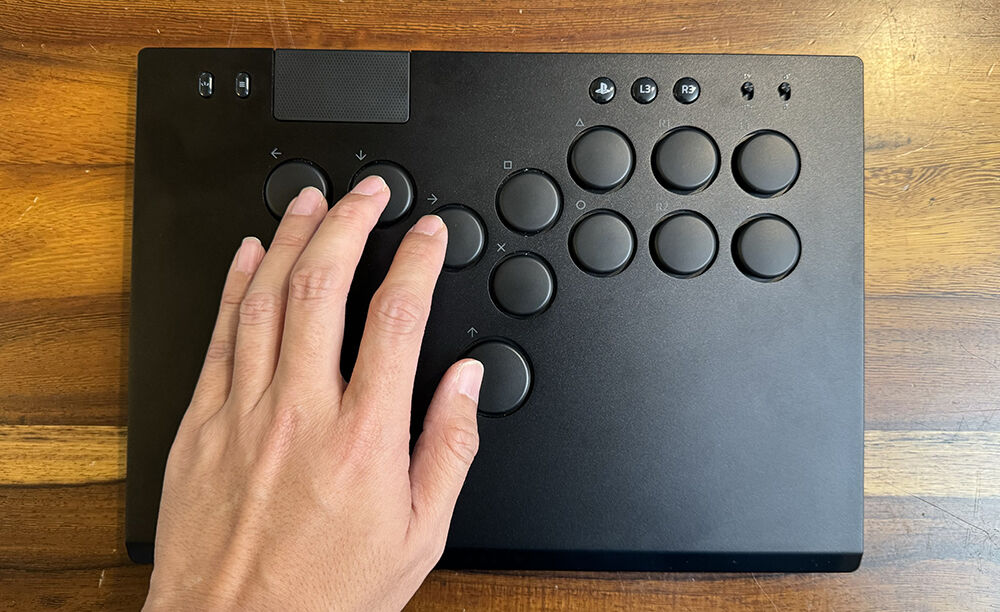The arcade controller has been a staple for fighting games since the early 90s, starting with the humble joystick and its iconic Sanwa 24mm or 30mm arcade buttons. That reigned supreme until roughly 20 years later, when the new kid on the block the Hitbox made its debut as a leverless controller marketed to help players execute moves faster by using movement-centric arcade buttons.
The Hitbox was met with extreme criticism and controversy, with the Fighting Games Community (FGC) believing that players using leverless controllers are cheating, as the buttons offer direct input and greatly reduce the travel time between directions compared to the joystick. Nevertheless, the FGC has, over time, come to accept the competitive use of leverless controllers even if some still look at them with raised eyebrows. The Hitbox, although sensational, comes with its own set of problems and Razer’s answer to those problems is the Razer Kitsune, and while the Kitsune is a premium work of art that solves the Hitbox’s deficiencies, it introduces some pet peeves of its own.

The Razer Kitsune is an all-button arcade controller designed specifically for the PlayStation 5 and PC. At the premium price of S$459.90, expanding the compatibility to Xbox consoles should have been a requirement., The Kitsune features 12 high-quality buttons (Four directional and eight action), as well as the associated secondary ones on the PlayStation Dualsense controllers on its surface. As with most Razer products, its build sports an elegant, sturdy, and sleek black aluminum frame.
What the Kitsune successfully solves when it comes to arcade controllers is its portability as controllers like the Hitbox are thick, bulky, and cumbersome to bring around. Considering how troublesome it is to lug a Hitbox in a dedicated backpack, the iPad-sized Razer Kitsune is a technological marvel, measuring 296mm x 210mm x 19.2mm. It is astonishingly lightweight as well, at just 800g, it’s amazing how anyone can manufacture an arcade controller so flat that it can slide into all types of backpacks, laptop cases, or sling bags. You might think that something so slim can have its exteriors bend, scratch, or break easily, but it is evident that Razer spares no expense in ensuring the Razer Kitsune is resilient to drops and dents.
Just like most conventional arcade controllers, the Hitbox is no stranger to frustrated players complaining about accidental disconnections or struggling to keep their bulky boxes on their laps during prolonged play times. Addressing these problems requires money to install locking mechanisms and kitbashing rubber mats together. Meanwhile, the Razer Kitsune beats the lights out of those issues as it comes with its rubber mat at its base, which keeps the Kitsune in place regardless of the surface the controller is resting on, and even when players are mashing on buttons in the heat of the battle. It also comes with a locking mechanism for its accompanying braided USB-C to type A cable, which keeps the controller connected even when players tug their controllers too hard or if someone trips on the cables.

Additionally, the controller comes with a Tournament Lock switch which disables the activation of the secondary buttons above the 12 primary direction and action buttons. Flipping the switch to Tournament Lock mode disables the PS home button, Create, Start, and L3/R3. It is also worth noting that these secondary buttons are tactfully separated, which forces the player to consciously reach out to them should they wish to press them. It’s frustrating when you are climbing the ranks for any fighting game and unexpectedly find yourself staring at the PlayStation home screen just because you accidentally hit the PS home button. When buttons are positioned out-of-sight and out-of-mind, and with the Tournament Lock switched on, players can keep their head in the game without breaking their focus or flow states.
But while the secondary buttons are well separated, the positioning of the Start and Create buttons requires some getting used to. Emulating the PlayStation Dualsense controller, the Create button is positioned at the top-left corner while the Start button is positioned between the Create button and the touchpad. It feels a little odd at first, as the start button is generally used more, and it feels more natural for any player to reach for the top corners of a game controller for a Start button without having to look. If you wish to press the Start button, you will need to consciously look and feel for it within the first few hours of using the Kitsune before getting used to its placement.
From the get-go, the Razer Kitsune is a fairly comfortable device to use for any type of fighting game, including Tekken 8 and Guilty Gear: Strive. The 12 primary buttons are built on Razer’s proprietary low-profile optical switches, which are marketed to have shorter actuation and offer greater response. Unfortunately, the differences in response time between these switches and other low-profile switches like the Kailh Choc V2 or even the conventional Sanwa arcade buttons feel negligible. Now Razer says that the low-profile optical switches for the Razer Kitsune are hot-swappable, and they are but the problem is that the Kitsune only uses low-profile optical switches, and while the stock switches alone will suffice to accommodate most fighting gamers, the market for low profile optical switches is still in its infancy, with only a limited inventory offered by Keychron, Kailh, and Nuphy for players to explore further customization.

On the other hand, leverless arcade controllers focusing on arcade buttons like the Hitbox have a wider, more established array of brands that offer different arcade button experiences by Sanwa, Qanba, and even GamerFinger switches. Should the user like to explore low-profile switch options, they can only wait for Razer or the keyboard community to offer a wider variety of products.
On top of that, users may find the hot-swapping process to require copious amounts of patience and skill, even with the proper tools used to swap keyboard switches. Popping off both the button caps and optical switches is a fairly tedious process. In comparison, these switches are found in many low-profile mechanical keyboards which usually can be easily changed. You will be attempting to remove the stock switches hoping it doesn’t break as you see the plastic top housing fasteners of the switch bend while firmly staying rooted on the PCB. It would go a long way if instructions or tools that intuitively guide players through the hot-swapping process were included – show a gamer how to correctly remove the button caps without having to wedge two keycap pullers on the side while praying nothing breaks. No one likes to brick a $500 controller just because they are not familiar with how they can change the buttons to their liking.
Another hot-swappable component for the Razer Kitsune is its aluminum faceplate. Having removable faceplates is an excellent idea but the Kitsune’s faceplate customizations are currently only limited to surface-applied skins, with current designs for Street Fighter 6’s Cammy and Chun-Li, and other generic skins available off the shelves. The part of the FGC community with an eye for custom arcade controllers love collecting and displaying printed faceplates or cutouts wedged between acrylics on shelves and while skins may be an economic solution for collectors, they will probably not appeal to the demographic looking to place custom faceplates on display. A deeper level of customization for the faceplates in Razer Customs would be a welcome feature, where consumers can get their own designs printed onto the plates instead (Think printed Xbox controllers by the Xbox Design Lab).

Although Razer provides specifications and services for gamers to design their own skins, these skins are only topologically applied. If top shells for Razer mice can be printed and personalized through a “Design Your Own” function, it is strange that the same level of customization is not present for the Kitsune’s aluminum faceplates. The best ways for consumers to get printed plates now are, unfortunately, from third-party printing companies, which may not be approved nor licensed by Razer.
Nevertheless, should players use the Kitsune as their controller of choice for official tourneys like EVO, they can rest assured it will be permitted without prejudice. Tournaments by the FGC require controllers used by players to be “Simultaneous Opposing Cardinal Directions” (SOCD) cleaned. SOCD-cleaned controllers help fighting games read opposing directional inputs of fighters to result in Neutral (no input) when opposing directions like the Up and Down or Left and Right are pressed at the same time. As part of their partnership with Capcom and Street Fighter 6, Razer has made it mandatory for all Kitsunes to be SOCD cleaned, and there is no way players without in-depth software development knowledge can change that.
Like most Razer products, the Razer Kitsune also comes with Razer Chroma RGB LEDs which help create an ethereal-looking fill around the surface wherever the Razer Kitsune is placed. The LEDs can be toggled to different modes or switched on or off to the players’ liking. Gamers playing in the dark with the Razer Kitsune will need to depend on their familiarity with the controller as the button symbols are not illuminated with the same LEDs. If Razer is looking to create a second iteration of the Razer Kitsune, utilizing the Razer Chroma for button indications would be a great step forward.
Priced at S$459.90, the Razer Kitsune is great for its excellent build quality and cool LED features. Fighting game enthusiasts of all levels may find other arcade controllers that suit their needs, but for what it is worth, the Razer Kitsune is a tournament-ready leverless controller that effectively solves the problems posed by traditional arcade controllers – that is if gamers can afford it.
GEEK REVIEW SCORE
Summary
The Razer Kitsune is a premium leverless controller that mostly excels in its manufacturing quality, sleek LEDs, and anti-accident features, which appeal to both fighting game novices and tournament seekers. The caveat lies in its limitations in customizability and a slight difficulty curve for users not familiar with the leverless configuration to get used to.
Overall
8/10-
Aesthetics - 9/10
9/10
-
Build Quality - 8.5/10
8.5/10
-
Performance - 8/10
8/10
-
Value - 7.5/10
7.5/10
-
Geek Satisfaction - 7/10
7/10













